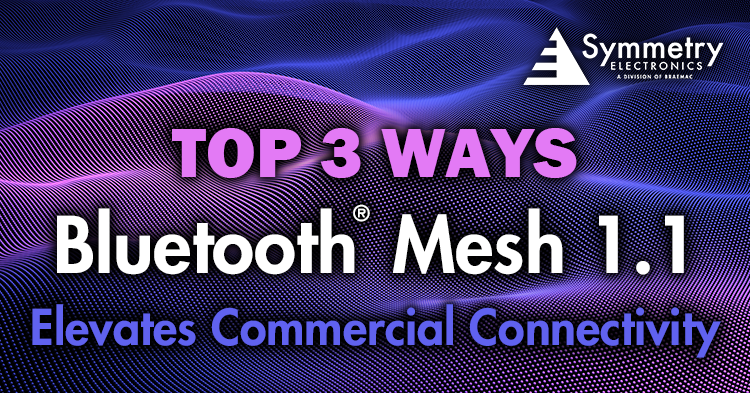- Home
- Symmetry Blog
- Top 3 Ways Bluetooth® Mesh 1.1 Elevates Commercial Connectivity
Top 3 Ways Bluetooth® Mesh 1.1 Elevates Commercial Connectivity
About Jari Haiston
.png)
From managing inventory to ensuring efficient communication between devices, businesses rely heavily on robust network infrastructures. The latest Bluetooth® Mesh 1.1 update is a game-changer, offering significant advancements that elevate commercial connectivity to new heights through enhanced range, improved energy efficiency, and increased security.
What’s New with Bluetooth Mesh 1.1?
Bluetooth Mesh 1.1 is an advanced networking protocol that enables devices to communicate with each other through mesh network topology. Unlike traditional Bluetooth connections, which are point-to-point, Bluetooth Mesh 1.1 allows multiple devices to interconnect and form a robust, scalable network. Within the update, Bluetooth Mesh 1.1 delivers six new features:
- Directed Forwarding: Enhances message delivery efficiency with a multi-hop method, allowing relay nodes to create direct paths from the source to the destination.
- Subnet Bridging: Maintains the ability to include subnets for area isolation while simplifying network complexity. It enables selective communication between specific devices in adjacent subnets without requiring knowledge of the NetKey.
- Certificate-Based Provisioning: Utilizes manufacturer-provided digital certificates for authenticating device identities. Only authenticated devices are permitted to join the network.
- Remote Provisioning: Provides the flexibility to add unprovisioned devices to the network from anywhere within the building, as provisioning can now occur over one or more hops.
- Automatic Device Firmware Updates: Allows a designated device to monitor for updates, obtain the necessary binary images, and distribute them across the network to update the appropriate nodes.
- Private Beacons: Enhances security and user privacy by ensuring that beacon messages do not contain static information, thereby preventing exposure of sensitive data.
3 Ways to Improve Commercial Connectivity with Bluetooth Mesh 1.1
Bluetooth Mesh 1.1 offers a powerful solution for enhancing commercial connectivity through its extended range, improved energy efficiency, and heightened security. These advancements not only improve operational efficiency but also contribute to cost savings and data protection.
As businesses continue to adopt IoT technologies and interconnected devices, Bluetooth Mesh 1.1 stands out as a vital tool for ensuring robust and reliable connectivity. Here are the top three ways Bluetooth Mesh 1.1 revolutionizes connectivity in commercial settings:
1. Enhanced Range and Coverage
One of the main features of Bluetooth Mesh 1.1 is its ability to significantly extend range and network coverage. By utilizing relay nodes, Bluetooth Mesh 1.1 can transmit messages over greater distances, ensuring that even remote or hard-to-reach areas within a commercial space are covered.
For example, in a large warehouse, sensors and devices located far from the central hub can still maintain reliable communication through the mesh network. The introduction of directed forwarding, one of Mesh 1.1’s newest features, allows line-powered devices to relay messages more efficiently. This enhanced range and coverage translates to fewer connectivity dead spots, improved operational efficiency, and better overall performance.
2. Improved Energy Efficiency
Energy efficiency is a critical consideration in commercial settings where devices often operate continuously. Bluetooth Mesh 1.1 addresses this by incorporating several energy-saving methods like optimized message transmission, efficient power management protocols, and support for low-power nodes.
In large networks, some devices are battery-powered and need to conserve energy, while others are line-powered. For example, a sensor measuring pressure in a gas line may be battery-powered, whereas a light bulb would be line-powered. Both of these device types can now communicate with each other using Bluetooth Mesh 1.1. Line-powered devices often provide the backbone in the mesh network, acting as repeaters to ensure reliable communication paths. By reducing energy consumption, businesses can lower operational costs and extend the battery life of their devices.
3. Increased Security
Bluetooth Mesh 1.1 introduces robust security features to protect commercial networks from potential vulnerabilities. These features include encryption of messages, secure key exchanges, and mechanisms to prevent unauthorized access.
By ensuring that data transmitted across the mesh network is encrypted and secure, businesses can safeguard sensitive information and maintain the integrity of their operations. Increased security in Bluetooth Mesh 1.1 provides peace of mind, allowing businesses to focus on their core activities without worrying about potential cyber threats.
Bluetooth Mesh 1.1 Solutions Available at Symmetry Electronics
Symmetry Electronics, a Division of Braemac, offers cutting-edge Bluetooth Mesh 1.1 solutions designed for various commercial needs, including both battery-powered and line-powered applications. Silicon Labs provides devices like the EFR32BG22 (SoC) and BGM220P (module) as battery-powered solutions. For line-powered applications, their EFR32BG24 (SoC) and BGM240P (module) are available.
Nordic Semiconductor offers the nRF5340, which does not differentiate between battery and line-powered devices. However, Nordic's highly anticipated next generation nRF54 series does address this distinction. The nRF54L15 is designed for low power, while the nRF54H20 offers high performance at the expense of higher power consumption. Both of these devices are currently sampling, and it might be worthwhile to contact Nordic for the official release timeline to provide accurate information in your publications.
